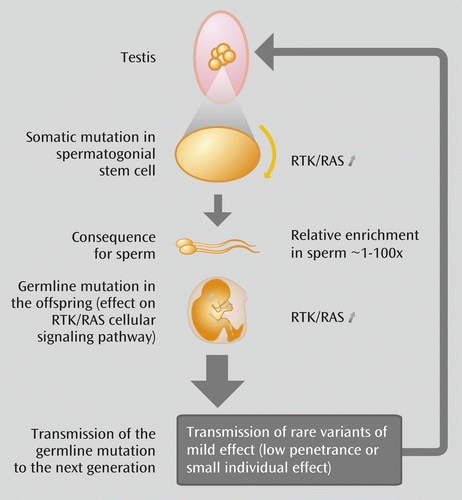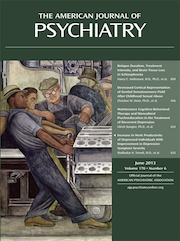In This Issue
Father’s Age and Mental Disorders
The propensity of older fathers to have offspring with schizophrenia, autism, or other neurodevelopmental disorders may be due to “selfish spermatogonial selection.” Goriely et al. (CME, p. Original article: 599) explain that male germ (spermatogonial) cells undergo many more cell divisions as men age. In the process, the sperm can develop mutations pathogenic for mental disorders in the offspring that may survive preferentially because these mutations also promote the survival of the sperm progenitor cells (figure).

Relapse is less likely in patients with five or more previous episodes of depression if they receive a course of cognitive-behavioral therapy (CBT) after remission, in addition to standard care. Stangier et al. (p. Original article: 624) did not find better outcomes in patients with three or four previous episodes. CBT was superior to psychoeducation, an intervention that controlled for more general therapeutic elements.
Veterans Health Administration records for more than 300,000 depressed patients during 2004–2009 indicate that citalopram daily doses above 40 mg are not associated with a higher risk of ventricular arrhythmia or death from either cardiac or noncardiac causes. These results do not support the 2011 FDA warning that doses above 40 mg may cause abnormal heart rhythms, which was based on individual cases and one study of 119 patients. Zivin et al. (p. Original article: 642) also compared citalopram with sertraline, not subject to the FDA warning, and found that sertraline has a similar risk pattern.
Relapse, Treatment, and Brain Tissue Loss in Schizophrenia
Brain imaging of patients with schizophrenia over 5–18 years showed that decrease in brain tissue volume was related to both total duration of symptom relapses and amount of antipsychotic treatment. Andreasen et al. (p. Original article: 609) note that tissue loss associated with relapse duration largely occurred in the frontal lobe, whereas loss related to treatment intensity was more diffuse. Both effects were relatively small. The editorial by Sweeney (p. Original article: 571) suggests clinicians consider using the lowest effective antipsychotic dose to prevent relapse, rather than raising it to just below the threshold for significant side effects.
Childhood Abuse and Neural Plasticity
A cortical area of the brain that processes genital sensation was thinner in women reporting childhood sexual abuse than in women without childhood abuse. Heim et al. (p. Original article: 616) also discovered that emotional childhood abuse was linked to thinning in regions involving self-awareness and self-evaluation. These abuse-specific differences suggest adaptation that may shield the child from abusive experiences but underlie later behavioral problems. Further, Oquendo et al. state in an editorial (p. Original article: 574) that responses to childhood sexual abuse can be life-threatening and multigenerational.
Depression Treatment and Work Function
Even partial response to initial antidepressant treatment improved work productivity in the STAR*D study. Among 1,928 employed depressed patients who reported impaired work performance at baseline, a decrease in symptom severity after initial treatment was associated with improvement in occupational functioning. However, for patients with initial treatment failures, Trivedi et al. (p. Original article: 633) report remission after the second treatment did not improve work performance more than a second nonresponse. In an editorial (p. Original article: 578), Greden envisions a confluence of employer involvement and personalized treatment that will address depression early and successfully.



